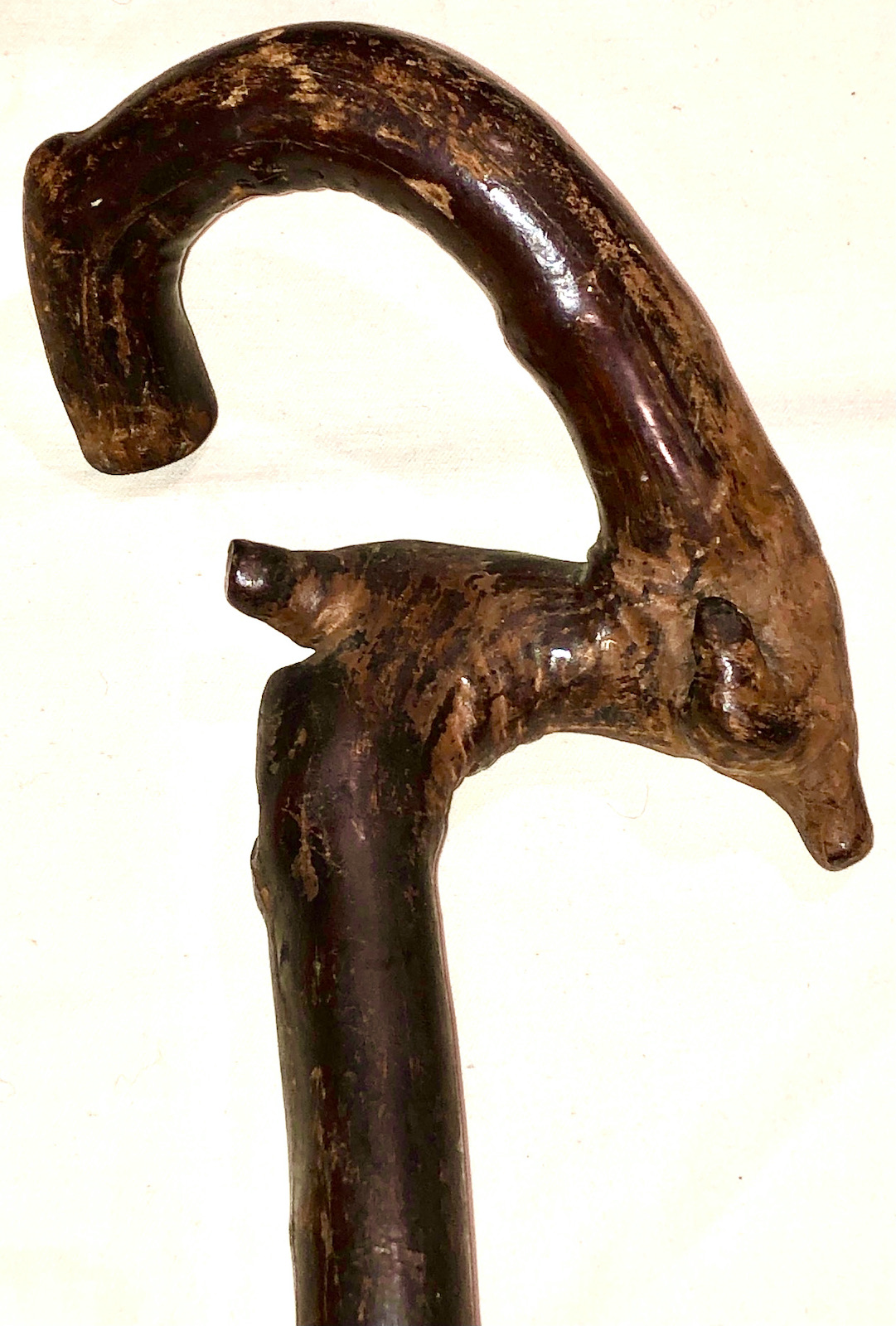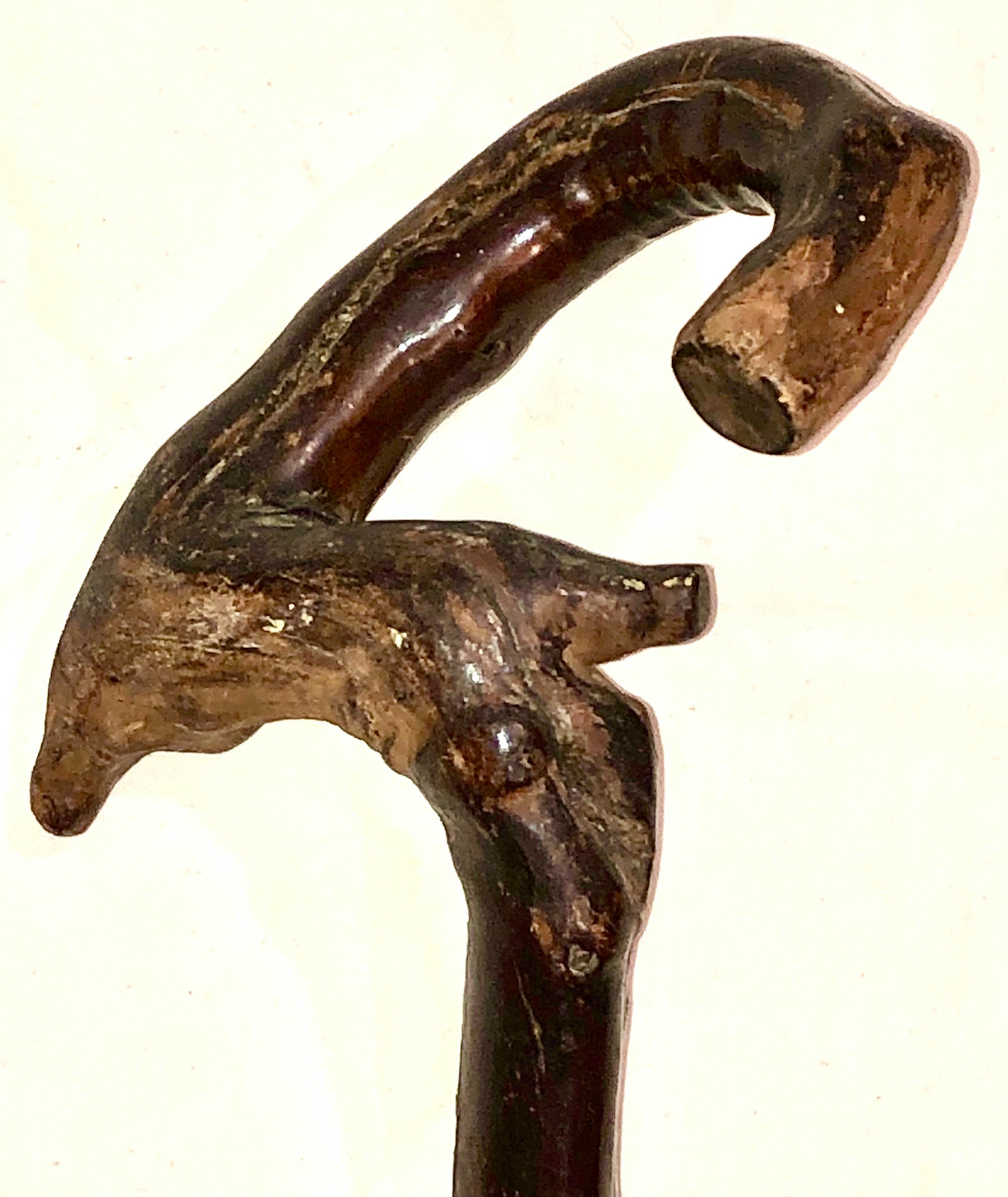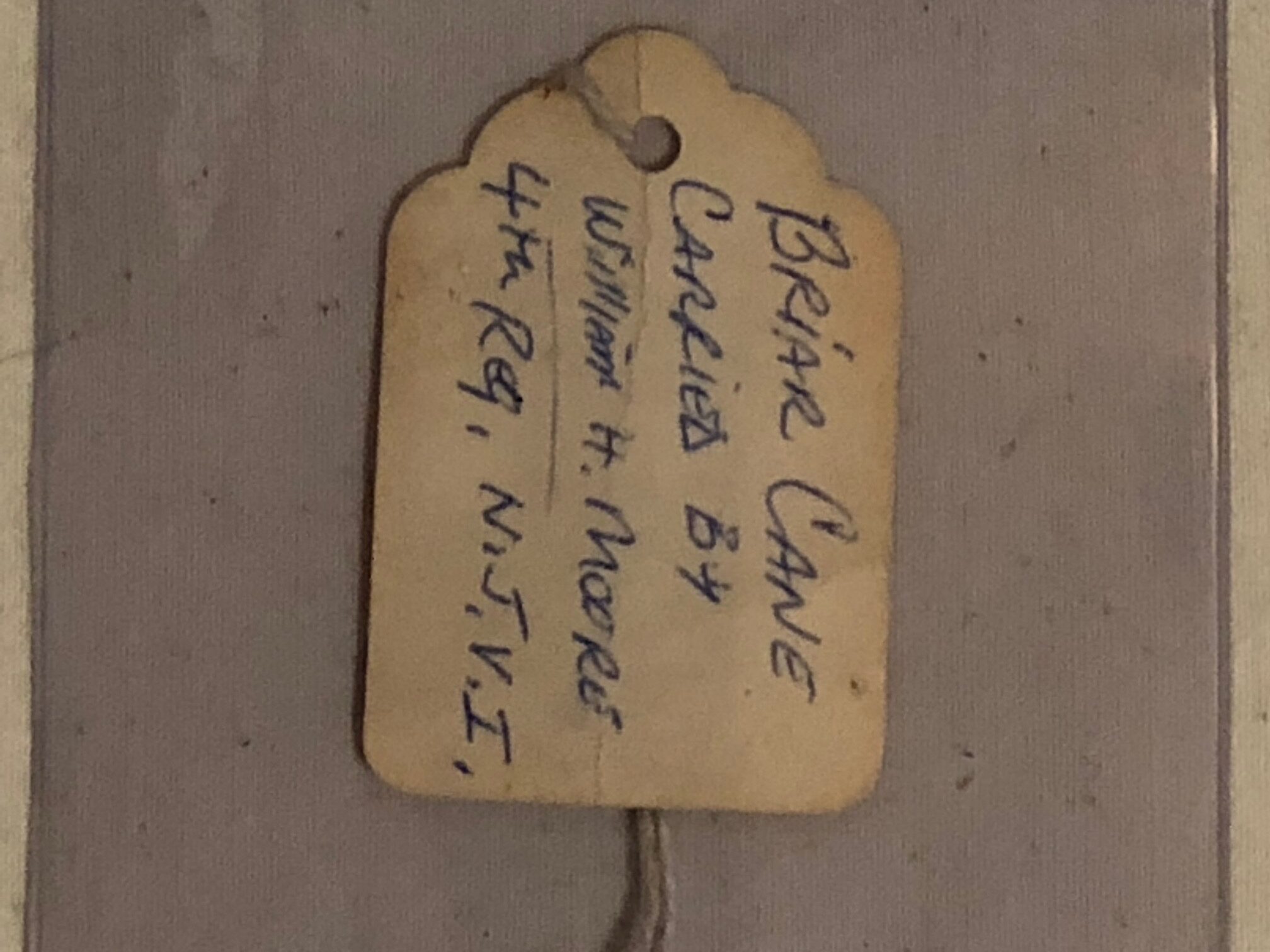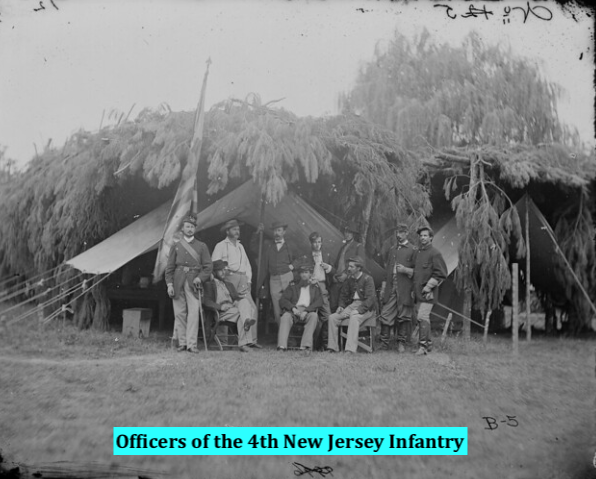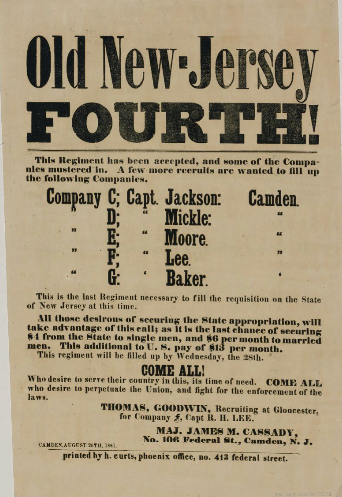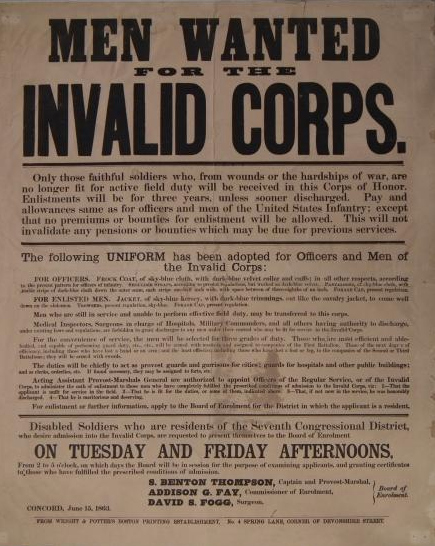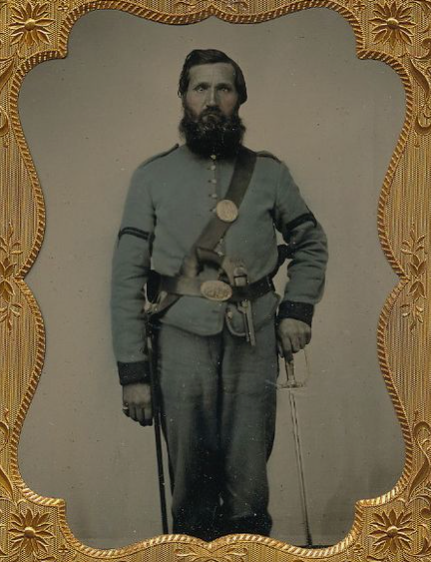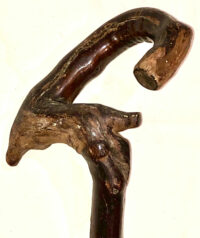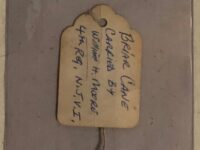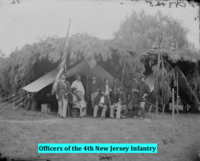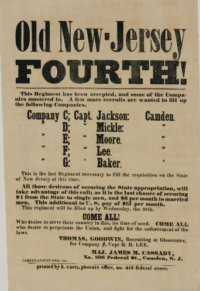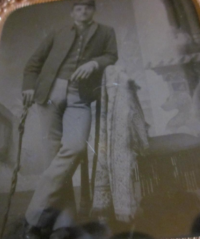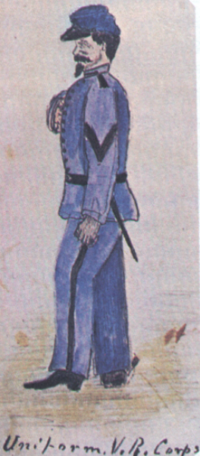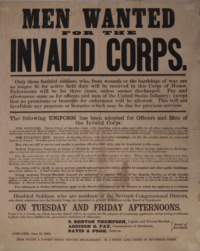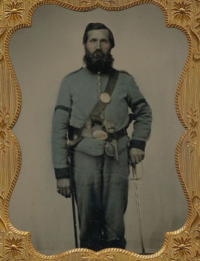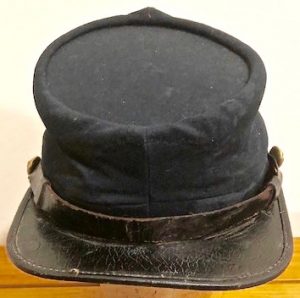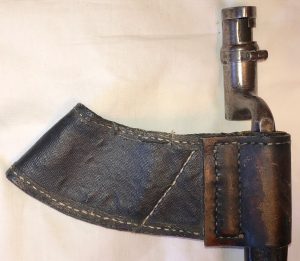Id’d Briar Wood Cane – Private Wm. H. Moore Co. E 4th New Jersey Infantry
Id’d Briar Wood Cane – Private Wm. H. Moore Co. E 4th New Jersey Infantry – This is a fine example of a Civil War period, hand crafted, soldier’s cane, constructed out of a heavy, briar or burl wood, with a highly gnarled hand or palm grip area. The cane retains a pleasing, aged patina, as well as its period, somewhat crudely fashioned, long, cone-shaped, iron tip. The cane remains in excellent condition. When the cane was obtained, at a small, Mid-Western, auction, it had an old tag attached which still accompanies the cane; the tag reads, as follows:
“Briar Cane
Carried By
William H. Moore
4th Reg. N.J.V.I.”
Private Moore enlisted in the 4th New Jersey, in August of 1861; his health was apparently negatively impacted during his service, either by wounding or illness, for he transferred into the Veteran Reserve Corps, in September of 1863, assumedly requiring the use of this cane. Moore would have been actively engaged with the 4th NJ, until his transfer into the VRC, thereby participating, with his regiment, in the following engagements: First and Second Bull Run, The Siege of Yorktown, The Seven Days’ Battles, Gaines’ Mill, Glendale, Malvern Hill, South Mountain and Antietam. The cane measures 36“ in length.
William H. Moore
| Residence was not listed;
Enlisted on 8/15/1861 as a Private.
On 8/15/1861 he mustered into “E” Co. NJ 4th Infantry He was transferred out on 9/30/1863
On 9/30/1863 he transferred into Veteran Reserve Corps He was discharged on 8/15/1864
|
NEW JERSEY
FOURTH INFANTRY
(Three Years)
|
Fourth Infantry.–Cols., James H. Simpson, William B. Hatch, William Birney, Edward L. Campbell; Lieut.-Cols., J. L. Kirby Smith, Barzilla Ridgway, Charles Ewing, Baldwin Hufty; Majs., Samuel Mulford, David Vickers. The 4th was organized under the provisions of an act of Congress, approved July 22, 1861. It was fully organized, equipped and officered by Aug. 19, at which time it was mustered into the U. S. service for three years, at Camp Olden, Trenton. It left the state the next day with 38 officers, 871 non-commissioned officers and privates, a total of 909. It reached Washington on Aug. 21, accompanied by a battery of 6 pieces, furnished by the state and commanded by Capt. William Hexamer, who had been waiting for six months for an opportunity to enter the service. It was assigned to the brigade of Gen. Kearney, then consisting of the 1st, 2nd and 3d N. J. regiments. Immediately after the first battle of Bull Run it joined the brigade near Alexandria, and in the operations along the line of the Orange & Alexandria railroad acted as a support to the advance. Just before the battle of West Point, Va., the brigade relieved the troops in advance and the men lay on their arms in line of battle until daylight, when they were ordered forward, the 4th being held as a reserve. At the battle at Gaines’ mill the brigade was formed in two lines, the 4th being in the front, and advanced to the brow of a hill, where the 4th was sent into the woods by order of an aid of Gen. McClellan, all the brigade being engaged at the most dangerous and difficult parts of the field, until at last, wearied, bleeding, ammunition exhausted, the brigade slowly retired and crossing the bridge at 11 o’clock, reached its old camp about midnight, having sustained a total loss of over 1,000 men in killed and wounded, of whom some 500, belonging to the 4th were captured in a body, having refused to retreat from the woods when they might have done so, and continuing to fight until completely surrounded. Besides this loss in prisoners the regiment lost 38 killed and 111 wounded. The regiment participated in the battles of Charles City cross- roads, White Oak swamp, Malvern hill, Manassas, Chantilly and Crampton’s gap, the total loss of the brigade during the latter engagement being 174 in killed and wounded, Adjt. Studdiford being among the slain. It took part in the movement against Fredericksburg, but in the Gettysburg campaign the 4th was detailed for provost duty in Washington. It was back with the brigade again in time for the spring campaign of 1864. At the battle of the Wilderness the 1st, 4th and 10th regiments, lying on the left, were several times attacked with great ferocity by the Confederates, but at nightfall still held substantially the ground occupied by them in the morning–a heavy assault by the Confederate Gen. Gordon just at dusk being repulsed with heroic Gallantry. Among the wounded in that engagement was Lieut.- Col. Van Syckel of the 4th. At the battle of Spottsylvania the regiment participated in the charge upon the “bloody angle,” winning its share of the glory and sustaining its share of casualties. During the first eleven days of Grant’s campaign against Richmond the regiment lost 26 killed, 126 wounded and 42 missing. The 4th fought at the North Anna river, Hanover Court House, Totopotomoy creek, Cold Harbor, Weldon railroad, Snicker’s gap, Strasburg, Winchester and Charlestown. At the battle of the Opequan the 4th was with the troops that pressed forward, swept up the opposite hill and forced back the Confederate line, obtaining permanent possession of the hill and holding it, though constantly exposed to a fire which inflicted severe loss, the 4th having 2 killed, 18 wounded and 1 missing. At Fisher’s hill a private of the 4th named Beach compelled a Confederate lieutenant-colonel to surrender his sword, and there were other instances of daring no less noteworthy. After Lee’s surrender the regiment was assigned to what was known as the provisional corps, Army of the Potomac, until mustered out on July 9, 1865. The total strength of the regiment was 2,036, and it lost during service 29 by resignation, 319 by discharge, 83 by promotion, 81 by transfer, 257 by death, 372 by desertion, 3 by dismissal, 109 not accounted for, mustered out 783. |
4th NJ Infantry
( 3-years )
| Organized: Camp Olden, Trenton, NJ on 8/19/61 Mustered Out: 7/9/65 at Hall’s Hill, VAOfficers Killed or Mortally Wounded: 5 Officers Died of Disease, Accidents, etc.: 2 Enlisted Men Killed or Mortally Wounded: 156 Enlisted Men Died of Disease, Accidents, etc.: 103 (Source: Fox, Regimental Losses) |
| From | To | Brigade | Division | Corps | Army | Comment |
| Aug ’61 | Oct ’61 | Kearney’s | Army of Potomac | New Organization | ||
| Oct ’61 | Mar ’62 | 1 | Franklin’s | Army of Potomac | ||
| Mar ’62 | Apr ’62 | 1 | 1 | 1 | Army of Potomac | |
| Apr ’62 | May ’62 | 1 | 1 | Department of Rappahannock | ||
| May ’62 | Jul ’64 | 1 | 1 | 6 | Army of Potomac | |
| Jul ’63 | Jul ’63 | Unatt Arty Res | Army of Potomac | |||
| Aug ’64 | Dec ’64 | 1 | 1 | 6 | Army of the Shenandoah | |
| Dec ’64 | Jun ’65 | 1 | 1 | 6 | Army of Potomac | Mustered Out |
| 4th New Jersey Infantry Regiment | |
| Active | April 27, 1861 to July 31, 1861 August 19, 1861 to July 9, 1865 |
| Country | United States |
| Allegiance | Union |
| Branch | Infantry |
| Engagements | First Battle of Bull Run (reserve) Siege of Yorktown Seven Days Battles Battle of Gaines’s Mill Battle of Glendale Battle of Malvern Hill Second Battle of Bull Run Battle of South Mountain Battle of Antietam Battle of Fredericksburg Battle of Chancellorsville Battle of Gettysburg Bristoe Campaign Mine Run Campaign Battle of the Wilderness Battle of Spotsylvania Court House Battle of Cold Harbor Siege of Petersburg Battle of Fort Stevens Battle of Fisher’s Hill Third Battle of Winchester Battle of Cedar Creek Third Battle of Petersburg Appomattox Campaign Battle of Appomattox Court House |
The 4th New Jersey Infantry Regiment was an infantry regiment in the Union Army during the American Civil War.
Service
Three months regiment
The 4th New Jersey Infantry Regiment was first organized at Trenton, New Jersey for three months service on April 27, 1861.
The regiment was attached to Runyon’s New Jersey Brigade, Defenses of Washington, to June 1861. 1st Brigade, Runyon’s Reserve Division, McDowell’s Army of Northeast Virginia, to July 1861.
Left New Jersey for Annapolis, Maryland, May 3. Reported to General Butler May 5, then moved to Washington, D.C., arriving there May 6. At Meridian Hill until May 24. Occupation of Arlington Heights, Va., May 24. Construction of Fort Runyon. Duty on line of Alexandria & Loudon Railroad until July 16. Advance on Manassas, Va., July 16-21. Battle of Bull Run July 21 (reserve).
The 4th New Jersey Infantry mustered out of service July 31, 1861.
Three years regiment
The 4th New Jersey Infantry was reorganized at Camp Olden in Trenton for three years service on August 19, 1861 under the command of Colonel James H. Simpson.
The regiment was attached to Kearney’s Brigade, Division of the Potomac, to October 1861. Kearney’s Brigade, Franklin’s Division, Army of the Potomac, to March 1862. 1st Brigade, 1st Division, I Corps, Army of the Potomac, to April 1862. 1st Brigade, 1st Division, Department of the Rappahannock, to May 1862. 1st Brigade, 1st Division, VI Corps, Army of the Potomac and Army of the Shenandoah, to July 1865.
The regiment was surrounded at Gaines Mill and most of its men taken prisoner. After the Seven Days Battles, they were freed by the Confederate authorities in a prisoner exchange. The 4th New Jersey had been armed with M1861 Springfield rifles, however upon returning from captivity, the authorities in Washington had no rifled muskets to rearm the regiment with, thus they were given outdated .69 smoothbore muskets. The regiment was forced to use them until the Battle of South Mountain in September, when they rearmed themselves with Enfield rifles dropped by retreating Confederates.
Left New Jersey for Washington, D.C., August 20, 1861. Duty in the defenses of Washington, D. C., until March 1862. Advance on Manassas, Va., March 8-15, 1862. Advance from Alexandria to Bristoe Station April 7-11. Embarked for the Virginia Peninsula April 17. Siege of Yorktown April 19-May 5 (on transports). West Point May 7-8. Reconnaissance to East Branch Chickahominy June 7 (Companies D, F, and I). Seven Days Battles before Richmond June 25-July 1: Battles of Gaines’s Mill June 27, Charles City Cross Roads and Glendale June 30, Malvern Hill July 1. At Harrison’s Landing until August 16. Movement to Fort Monroe, then to Manassas, Va., August 16-26. Pope’s Campaign in northern Virginia August 26-September 2. Bull Run Bridge, Manassas, August 27. Second Battle of Bull Run August 30. Cover Pope’s retreat to Centreville August 30-31. Maryland Campaign September 6-22. Battles of Crampton’s Pass, South Mountain, September 14. Battle of Antietam September 16-17. At Sharpsburg, Md., until October 29. Movement to Falmouth, Va., October 29-November 19. Battle of Fredericksburg December 12-15. At Falmouth until April 27, 1863. “Mud March” January 20-24. Chancellorsville Campaign April 27-May 6. Operations at Franklin’s Crossing April 29-May 2. Battle of Maryes Heights, Fredericksburg, May 3. Salem Heights May 3-4. Banks’s Ford May 4. Gettysburg Campaign June 11-July 24. Battle of Gettysburg July 2-4. Guarding ammunition train July. In camp near Warrenton, Va., until September 15, and at Culpeper Court House until October. Bristoe Campaign October 9-22. Advance to line of the Rappahannock November 7-8. Rappahannock Station November 7. Mine Run Campaign November 26-December 2. At Brandy Station to May 1864. Campaign from the Rapidan to the James May 3-June 15. Battle of the Wilderness May 5-7. Spotsylvania May 8-12. Spotsylvania Court House May 12-21. Assault on the Salient, “Bloody Angle,” May 12. North Anna River May 23-26. On line of the Pamunkey May 26-28. Totopotomoy May 28-31. Cold Harbor June 1-12. Before Petersburg June 17-18. Siege of Petersburg until July 9. Jerusalem Plank Road June 22-23. Moved to Washington, D.C., June 9-11. Repulse of Early’s attack on Fort Stevens and the northern Defenses of Washington July 11-12. Pursuit of Early to Snicker’s Gap July 14-23. Sheridan’s Shenandoah Valley Campaign August 7-November 28. Strasburg August 14-15. Cedar Creek August 15. Winchester August 17. Charlestown August 21-22. Battle of Winchester September 19. Fisher’s Hill September 22. Battle of Cedar Creek October 19, Duty in the Shenandoah Valley until December. Moved to Washington, D.C., then to Petersburg. Siege of Petersburg December 1864 to April 2, 1865. Dabney’s Mills, Hatcher’s Run, February 5-7, 1865. Appomattox Campaign March 28-April 9. Fall of Petersburg April 2. Pursuit of Lee April 3-9. Appomattox Court House April 9. Surrender of Lee and his army. March to Danville April 23-27 and duty there until May 18. Moved to Richmond, Va., then to Washington, D.C., May 18-June 3. Corps review June 8.
The 4th New Jersey Infantry mustered out of service July 9, 1865 at Hall’s Hill, Virginia.
Casualties
The regiment lost a total of 266 men during service; 5 officers and 156 enlisted men killed or mortally wounded, 2 officers and 103 enlisted men died of disease.
Commanders
- Colonel James H. Simpson – resigned August 24, 1862 to resume his duties as a majorin the Corps of Topographical Engineers
- Colonel William B. Hatch – commanded the regiment at the Battle of Gaines’s Mill while at the rank of lieutenant colonelafter Col. Simpson and 400 men from the regiment were captured; promoted to colonel August 26, 1862 and mortally wounded in action at the Battle of Fredericksburg
- Colonel William Birney– promoted to brigadier general May 22, 1863
- Colonel David Vickers – mustered out May 18, 1865
- Colonel Edward L. Campbell
- MajorCharles Ewing – commanded at the Battle of Gettysburg
- CaptainEbenezer Davis – commanded at the Battle of Fort Stevens
- Captain Baldwin Hufty – commanded at the Battle of Fisher’s Hill, Third Battle of Winchester, and Battle of Cedar Creek
Notable members]
- Sergeant John P. Beech, Company B – Medal of Honorrecipient for action at the Battle of Spotsylvania Court House
UNION NEW JERSEY VOLUNTEERS
4th Regiment, New Jersey Infantry
OVERVIEW:
Organized at Camp Olden, Trenton, N. J., and mustered in August 19, 1861. Left State for Washington, D. C., August 20, 1861. Attached to Kearney’s Brigade, Division of the Potomac, to October, 1861. Kearney’s Brigade, Franklin’s Division, Army of the Potomac, to March, 1862. 1st Brigade, 1st Division, 1st Army Corps, Army of the Potomac, to April, 1862. 1st Brigade, 1st Division, Dept. of the Rappahannock, to May, 1862. 1st Brigade, 1st Division, 6th Army Corps, Army of the Potomac and Army of the Shenandoah, to July, 1865.
SERVICE:
Duty in the Defences of Washington, D. C., till March, 1862. Advance on Manassas, Va., March 8-15, 1862. Advance from Alexandria to Bristoe Station April 7-11. Embarked for the Virginia Peninsula April 17. Siege of Yorktown April 19-May 5 (on transports). West Point May 7-8. Reconnoissance to East Branch Chickahominy June 7 (Cos. “D,” “F” and “I”). Seven days before Richmond June 25-July 1. Battles of Gaines Mill June 27; Charles City Cross Roads and Glendale June 30; Malvern Hill July 1. At Harrison Landing till August 16. Movement to Fortress Monroe, thence to Manassas, Va., August 16-26. Pope’s Campaign in Northern Virginia August 26-September 2. Bull Run Bridge, Manassas, August 27. Battle of Bull Run August 30. Cover Pope’s retreat to Centreville August 30-31. Maryland Campaign September 6-22. Battles of Crampton’s Pass, South Mountain, September 14; Antietam September 16-17. At Sharpsburg, Md., till October 29. Movement to Falmouth, Va., October 29-November 19. Battle of Fredericksburg, Va., December 12-15. At Falmouth till April 27, 1863. “Mud March” January 20-24. Chancellorsville Campaign April 27-May 6. Operations at Franklin’s Crossing April 29-May 2. Battle of Maryes Heights, Fredericksburg, May 3. Salem Heights May 3-4. Banks Ford May 4. Gettysburg (Pa.) Campaign June 11-July 24. Battle of Gettysburg July 2-4. Guarding ammunition train July. In camp near Warrenton, Va., till September 15, and at Culpeper Court House till October. Bristoe Campaign October 9-22. Advance to line of the Rappahannock November 7-8. Rappahannock Station November 7. Mine Run Campaign November 26-Decembor 2. At Brandy Station to May, 1864. Campaign from the Rapidan to the James May 3-June 15. Battles of the Wilderness May 5-7; Spottsylvania May 8-12; Spottsylvania Court House May 12-21. Assault on the Salient, “Bloody Angle,” May 12. North Anna River May 23-26. On line of the Pamunkey May 26-28. Totopotomoy May 28-31. Cold Harbor June 1-12. Before Petersburg June 17-18. Siege of Petersburg till July 9. Jerusalem Plank Road June 22-23. Moved to Washington, D. C., June 9-11. Repulse of Early’s attack on Fort Stevens and the Northern Defences of Washington July 11-12. Pursuit of Early to Snicker’s Gap July 14-23. Sheridan’s Shenandoah Valley Campaign August 7-November 28. Strasburg August 14-15. Winchester August 17. Charlestown August 21-22. Battle of Winchester September 19. Fisher’s Hill September 22. Battle of Cedar Creek October 19. Duty in the Shenandoah Valley till December. Moved to Washington, D. C., thence to Petersburg, Va. Siege of Petersburg December, 1864, to April 2, 1865. Dabney’s Mills, Hatcher’s Run, February 5-7, 1865. Appomattox Campaign March 28-April 9. Fall of Petersburg April 2. Pursuit of Lee April 3-9. Appomattox Court House April 9. Surrender of Lee and his army. March to Danville April 23-27 and duty there till May 18. Moved to Richmond, Va., thence to Washington, D. C., May 18-June 3. Corps Review June 8. Mustered out at Hall’s Hill, Va., July 9, 1865.
Regiment lost during service 5 Officers and 156 Enlisted men killed and mortally wounded and 2 Officers and 103 Enlisted men by disease. Total 266.


